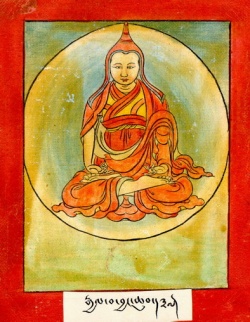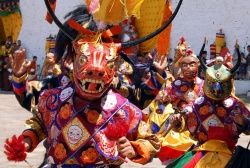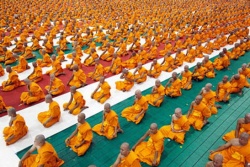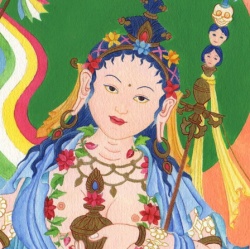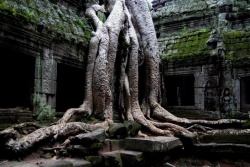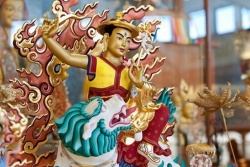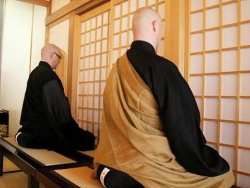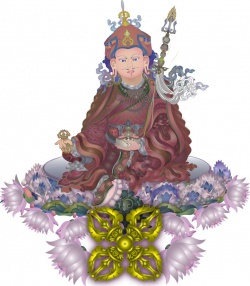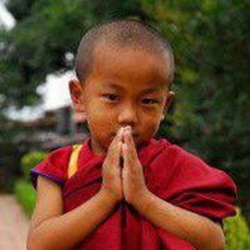The Buddhist faith originated in India
"Decay is inherent in all compounded things, so continue in watchfulness." The last recorded words of Siddhartha Gautama (Gotama), the founder of Buddhism, might be taken to mean, "Work out your own salvation with diligence" (Bowker 1997, p. 169). From its inception, Buddhism has stressed the importance of death because awareness of death is what prompted the Buddha to perceive the ultimate futility of worldly concerns and pleasures. According to traditional stories of the life of the Buddha, he first decided to leave his home and seek enlightenment after encountering the "four sights" (a sick person, an old person, a corpse, and someone who had renounced the world). The first three epitomized the sufferings to which ordinary beings were and are subject to, and the last indicates that one can transcend them through meditation and religious practice. The greatest problem of all is death, the final cessation of all one's hopes and dreams. A prince of the Shakya family in what is modern Nepal, Gautama became dissatisfied with palace life after witnessing suffering in the nearby city of Kapilavastu. At the age of 29, he renounced his former life, cut off his hair and started to wear the yellow robes of a religious mendicant. Buddhism, the faith he created through his teaching, thus originated in his heightened sense of suffering, and begins with the fundamental fact of suffering ( dukkha ) as the human predicament: "from the suffering, moreover, no one knows of any way of escape, even from decay and death. O, when shall a way of escape from this suffering be made known—from decay and from death?" (Hamilton, 1952, pp. 6–11).
Origins of Buddhist Faith
The Buddhist faith originated in India in the sixth and fifth centuries B.C.E. with the enlightenment of Gotama (in Sanskrit, Gauatama), the historical founder of the faith (c. 566–486 B.C.E. ). The teaching of Gotama Buddha, also known as Buddha Sakyamuni (that is, "the Wise One" or "Sage of the Sakya Clan") is summarized in the Four Noble Truths: the truth of suffering (existence is suffering); the truth of suffering's cause (suffering is caused by desire); the truth of stopping suffering (stop the cause of suffering (desire) and the suffering will cease to arise); and the truth of the way (the Eightfold Path leads to the release from desire and extinguishes suffering). In turn, the Eightfold Path requires right understanding, right thought, right speech, right action, right livelihood, right effort, right mindfulness, and right concentration. There is also a twelve-step chain of cause. This chain of conditions consists of (1) spiritual ignorance; (2) constructing activities; (3) consciousness; (4) mind-and-body; (5) the six sense-bases; (6) sensory stimulation; (7) feeling; (8) craving; (9) grasping; (10) existence; (11) birth; (12) aging, death, sorry, lamentation, pain, grief, and despair. This chain of cause or Doctrine of Dependent Origination explains the dukka that one experiences in his or her life. Finally, there is the continuing process of reincarnation. "If, on the dissolution of the body, after death, instead of his reappearing in a happy destination, in the heavenly world, he comes to the human state, he is long-lived wherever he is reborn" (Nikaya 1993, p. 135). Disillusioned with the ascetic path, Gotama adhered to what he called "the middle way." He chose to sit beneath a Bo or Bodhi Tree (believed by scholars to now be situated at Bodhgaya, Bihar), concentrating on "seeing things as they really are" and passing through four stages of progressive insight ( jhanas ), which led to enlightenment (scholars believe this stage was achieved in c. 535 B.C.E. ). The rest of his life was spent wandering in the area of the Ganges basin, gaining adherents and probably spending the rainy months in a community of followers, the beginnings of the Buddhist monastic establishment ( vihara ). The Buddha is said to have made no other claim for himself than that he was a teacher of transience or suffering (dukkha or duhkha ), the first of his Four Noble Truths.
Two and a half centuries after the Buddha's death, a council of Buddhist monks collected his teachings and the oral traditions of the faith into written form, called the Tripitaka. This included a very large collection of commentaries and traditions; most are called Sutras (discourses). Some twelve centuries after the Buddha's death, the faith spread from India into Tibet and from the early seventh century C.E. onward, Buddhism became firmly entrenched in all aspects of Tibetan society.
The significance of the conversion of Tibet lies in the exceptionally rich early literature that survives: The original Sanskrit texts of the Sutra on "Passing from One Existence to Another" and the Sutra on "Death and the Transmigration of Souls" are no longer extant and are known only through their Tibetan versions. Buddhism spread also to central and southeast Asia, China, and from there into Korea (c. 350–668 C.E. ) and Japan (c. 538 C.E. ). Although there have been conversions to Buddhism in modern times, especially the mass conversion of dalits (or untouchables) following the leadership of Dr. Bhimrao R. Ambedkar, the dispersion of the centers of Buddhist learning led to a dwindling of the faith in most of India during the centuries of Islamic predominance.
Buddhist Traditions
Buddhism has two (or in some interpretations, three) main divisions, or traditions: Mahayana and Hinayana. Those Buddhist adherents in Mongolia, Vietnam, China, Korea, and Japan follow Mahayana, the so-called Great Vehicle tradition, and those in Sri Lanka and southeast Asia, except Vietnam, where the Mahayan tradition was brought by Chinese settlers, follow Hinayana, also known as Theravada, the so-called Lesser Vehicle tradition. More controversial is whether Vajrayana (the "Diamond Vehicle" or Tantric tradition emanating from Mahayana, now dominant in Tibet and the Himalayas) constitutes a distinctive and separate tradition or not.
Mahayana emphasizes, among other things, the Sutras containing the developed teaching of the Buddha, and recognizes the Buddha-nature ( Buddhata, or Buddha-potential) in all sentient beings (and not exclusively humans). Mahayana emphasizes the feeling of the suffering of others as one's own, which impels the soul to desire the liberation of all beings and to encourage adherence to the "enlightenment" ( bodhisattva ) path. A bodhisattva is defined as one who strives to gain the experience of things as they really are (as in the experience of Gautama under the tree, hence the name bodhi ) and scorns nirvana "as he wishe(s) to help and succour his fellow-creatures in the world of sorrow, sin and impermanence" (Bowker 1997, p. 154). An early Buddhist, Candrakirti, calls nirvana "the cessation of every thought of non-existence and existence" (Stcherbatsky 1965, p.190).
In contrast, Hinayana or Theravada (the latter term meaning "teaching of the elders") emphasizes the aspect of personal discipleship and the attainment of the penultimate state of perfection ( arhat ). The followers of Mahayana view it as a more restricted interpretation of the tradition. There is also a basic disagreement on how many Buddhas can appear in each world cycle. In Theravada, there can only be one, the Buddha who has already appeared; hence only the penultimate state of perfection can be attained and Buddha-nature is not recognized. There are also other differences between the traditions, particularly with regard to the status of women (which is somewhat higher in the Mahayana tradition). Buddhism in its various manifestations is the world's fourth largest religion with about 362 million adherents in 2000,
CORBIS
or about 6 percent of an estimated world population of 6 billion.
The Sutra on "Passing from One Existence to Another" relates that during the Buddha's stay in Rajagriha a king named Bimbisara questioned him on the transitory nature of action ( karma ) and how rebirth can be effected by thoughts and actions, which are by their very nature momentary and fleeting. For the Buddha, an individual's past thoughts and actions appear before the mind at the time of death in the same way that the previous night's dreams are recalled while awake; neither the dreams nor past karma have any solid and substantial reality in themselves, but both can, and do, produce real effects. An individual's past karma appears before the mind at the final moment of death and causes the first moment of rebirth. This new life is a new sphere of consciousness in one of the six realms of rebirth (the worlds of the gods, demigods, humans, hungry ghosts, animals, and hell-beings) wherein the person experiences the fruits of his or her previous actions.
The discourse on "The Great Liberation through Hearing in the Bardo" is one of a series of instructions on six types of liberation: liberation through hearing, wearing, seeing, remembering, tasting, and touching. It is a supreme example of Tibetan esoteric teaching on how to assist in the "ejection of consciousness" after death if this liberation has not happened spontaneously. If the body is present, the guru or dharma-brother, that is, the fellow-disciple of the guru, should read the text of the Sutra close to his ear three or seven times. The first bardo, or intermediate state between life and death, is called "the luminosity of the essence of reality ( dharmata )"; it is a direct perception of the sacredness and vividness of life (Fremantle and Trungpa 1975, p. 36). The work is thought to have been written by Padmasambhava, known by his followers as "precious teacher" (Guru Rinpoche), a great eighth-century Tantric master and founder of the Nyingma school. He is considered by Tibetans to be a second Buddha. He describes in detail the six bardos, or intermediate states, three of which comprise the period between death and rebirth and three which relate to this life: the bardo of birth; the bardo of dreams; the bardo of meditation, in which the distinction between subject and object disappears ( samadhi, or meditation); the bardo of the moment before death; the bardo of the essence of reality ( dharmata ); and the bardo of becoming.
The Tibetan Book of the Dead
The German Tibetologist and scholar of comparative religion Detlef Lauf regarded the Tibetan Book of the Dead ( Bar-do thos-grol or Bardo Thodrol, or Thötröl ) as an example of "yoga-practice" (Yogacara) or Vijnanavada idealism, "which proceed(s) from the premise that karmically laden awareness by far outlasts the earthly life span of the individual." This branch of Mahayana philosophy "places above all conceptualisation emptiness, suchness [sic], pure buddha-nature, or the crystal clear diamond nature of human awareness, which is of imageless intensity. . . . Therefore the Tibetan Book of the Dead can first proclaim the philosophical reality of the buddhas and their teachings, and after these have been grasped and penetrated, it can then say that these are only illusory images of one's own consciousness, for the pure world within needs no images of external form" (Lauf 1977, pp. 225–226).
Mind or pure awareness is, in Vijnanavada theory, "the indispensable basis and essence of reality and is therefore absolute. Because nothing is imaginable without mind, it is called the absolute, or allpervading emptiness, or simply nirvana " (ibid., p. 221). Although appearing to be an instruction manual for the guidance of human awareness after death, Lauf argued that the Bardo Thodrol was in reality "primarily a book of life, for the knowledge of the path through the bardo must be gained 'on this side' if it is to be put into practice 'on the other side'" (ibid., p. 228).
Lauf also generalized from the various Tibetan texts the duration of the bardo state: "It is generally accepted that the total time of the intermediate state between two successive earthly incarnations is forty-nine days. The various cycles of emanation of the deities divide this time into a rhythm that is always determined by the number seven. . . . From the fourth to the eleventh day there is the successive emanation of the forty-two peaceful bardo deities from out of the fivefold radiant light of the buddhas. From the twelfth until the nineteenth day the fifty-eight terrifying deities take shape out of the flames, and the journey through the (bardo and the experience of the worlds of hell) Srid-pa'i bardo lasts . . . twenty-one days in all. The last seven days are dedicated to the search for the place of rebirth which is supposed to take place on the eighth day . . ." (pp. 95–96).
Two modern approaches to the Tibetan Book of the Dead deserve mention. Based on lectures presented at his own Buddhist institute in Vermont, the charismatic Tibetan teacher Chögyam Trungpa (1939–1987) published his own edition of the work in 1975 with Francesca Fremantle. His highly individualized commentary to the translation certainly owes a debt to the psychoanalyst Carl Jung. In Chögyam Trungpa's view, the bardo experience is an active part of every human being's basic psychological makeup, and thus it is best described using the concepts of modern psychoanalysis, such as ego, the unconscious mind, neurosis, paranoia, and so on. This view was popularized in Trungpa's Transcending Madness: The Experience of the Six Bardos (1992).
A second approach is that of Robert Thurman, a professor at Columbia University, the first American to be ordained a Tibetan Buddhist monk and president of Tibet House in New York City, who sets out to produce an accessible version of the Tibetan text for those who might wish to read it at the bedside of their dying friend or relative. In this way, Thurman's Tibetan Book of the Dead is presented clearly as an "easy-to-read" guidebook for contemporary Americans. It is "easy for bereaved relatives to read and for lost souls to hear in the room where they anxiously hover about their corpses and wonder what has happened to them . . ." (Sambhava and Thurman 1994, p. xxi).
Buddhism and Death and Dying
Robert Thurman's text leads to a consideration of the relationship of Buddhism to modern clinical medical ethics and attitudes to death and dying in particular as well as to the pastoral care of the terminally ill. The Swiss-born psychiatrist Elisabeth Kübler-Ross interviewed over 200 dying patients better to understand the psychological aspects of dying. She illustrates five stages that people go through when they know they are going to die. The stages include denial, anger, bargaining, depression, and acceptance. While a sequential order is implied, the manner is which a person comes to terms with impending death does not necessarily follow the order of the stages. Some of these phases are temporary; others will be with that person until death. The stages will exist at different times and can co-exist within each other. Denial and feelings of isolation are usually short lived. Isolation is related to the emotional support one receives. If a person feels alone and helpless he or she is more likely to isolate. During the anger stage, it is important to be very patient with the dying individual, who acts in apparent anger because of an inability to accept the reality of the diagnosis. Bargaining describes the period in which the ill person tries to bargain with doctors, family, clergy, or God to "buy more time."
When the denial, anger, and bargaining come to an end—and if the ill person continues to live— depression typically arises. Kübler-Ross talks about two forms of depression (reactive and preparatory). Reactive depression comes about from past losses, guilt, hopelessness, and shame. Preparatory depression is associated with impending loss. Most ill persons feel guilty for departing from family or friends, so require reassurance that life will change in the absence of the dead person but will nevertheless continue. The acceptance stage is a product of tiredness and numbness after the various preceding stages with their struggles. The model has been criticized and may not be applicable to the majority who die in old age, where a terminal diagnosis may be more acceptable to the individual. Many of the aged have experienced a gradual diminution of health and abilities that predates any knowledge of impending death. Such a diagnosis may be better accepted by the elderly both because of gradual infirmity and because approaching death is not viewed as a "surprise," but rather as part of a long and total life experience. For all the caveats, there are important resonances between the Kübler-Ross model and the stages of liberation in the bardo experience described above.
Julia Ching writes that "the central Mahayan insight, that Nirvana is to be found in the samsara, that is, in this life and this world, has made the religion more acceptable to the Chinese and Japanese" (Ching 1989, p. 217). She questions the content of Buddhist belief in East Asia: ". . . it appears that many Chinese, Japanese, and Korean Buddhists are less than clear about their belief in the cycle of rebirth. Their accounts of samsara include the presupposition of a wandering soul, which is not in accord with strict Buddhist teaching, and they tend to perceive life in linear terms. Besides, they frequently equate Nirvana with the Pure Land [named after Sukhavati, a Sanskrit word representing an ideal Buddhist paradise this side of Nirvana, believed to be presided over by the Buddha Amitabha, the Buddha of infinite life and light], and the Buddhas with the bodhisattvas" (1989, p. 220).
Ch'an and Zen, the respective Chinese and Japanese transliterations of the Sankrit word for meditation ( dyhana ) are a distinctively East Asian development of the Mahayana tradition. Zen teaches that ultimate reality or emptiness ( sunya ), sometimes called "Buddha-nature," is, as described by Ching, "inexpressible in words or concepts and is apprehended only by direct intuition, outside of conscious thought. Such direct intuition requires discipline and training, but is also characterized by freedom and spontaneity" (Ching 1989, p. 211). Japanese Buddhism, she contends, "is so closely associated with the memory of the dead and the ancestral cult that the family shrines dedicated to the ancestors, and still occupying a place of honor in homes, are popularly called the Butsudan, literally 'the Buddhist altars.' . . . It has been the custom in modern Japan to have Shinto weddings . . . but to turn to Buddhism in times of bereavement and for funeral services" (Ching 1989, p. 219).
The tradition of death poems in Zen accounts for one way in which the Japanese regard Buddhism as a funerary religion. Minamoto Yorimasa (1104–1180 C.E. ), lamented that "Like a rotten log / half buried in the ground— / my life, which / has not flowered, comes / to this sad end" (Hoffman 1986, p. 48). Shiaku Nyûdo (d. 1333) justified an act of suicide with the words: "Holding forth this sword / I cut vacuity in twain; / In the midst of the great fire, / a stream of refreshing breeze!" (Suzuki 1959, p. 84). At what would be considered the relatively youthful age of fifty-four, Ota Dokan (1432–1486) clearly considered himself in decline already by the time of death: "Had I not known / that I was dead / already / I would have mourned / my loss of life" (Hoffman 1986, p. 52). For Ôuchi Yoshitaka (1507–1551) it was the extraordinary event that was significant: "Both the victor / and the vanquished are / but drops of dew, / but bolts of lightning—thus should we view the world" (1986, p. 53). The same image of dew, this time reinforced by dreams, was paramount for Toyotomi Hideyoshi (1536–1598): "My life / came like dew / disappears like dew. / All of Naniwa / is dream after dream" (Berry 1982, p. 235). Forty-nine years had passed as a dream for Uesugi Kenshin (1530–1578): "Even a life-long prosperity is but one cup of sake; /A life of forty-nine years is passed in a dream / I know not what life is, nor death. Year in year out—all but a dream. / Both Heaven and Hell are left behind; / I stand in the moonlit dawn, / Free from clouds of attachment" (Suzuki 1959, p. 82). The mists that cloud the mind were swept away at death for Hôjô Ujimasa (1538–1590): "Autumn wind of eve, / blow away the clouds that mass / over the moon's pure light / and the mists that cloud our mind, / do thou sweep away as well. / Now we disappear, / well, what must we think of it? / From the sky we came. / Now we may go back again. / That's at least one point of view" (Sadler 1978, pp. 160–161).
The death poems exemplify both the "eternal loneliness" that is found at the heart of Zen and the search for a new viewpoint, a new way of looking at life and things generally, or a version of enlightenment ( satori in Japanese; wu in Chinese). Daisetz Suzuki writes: ". . . there is no Zen without satori, which is indeed the alpha and omega of Zen Buddhism"; it is defined as "an intuitive looking into the nature of things in contradistinction to the analytical or logical understanding of it." This can only be gained "through our once personally experiencing it" (1963, pp. 153, 154).
See also: Chinese Beliefs ; Hinduism ; Islam ; Last Words ; Moment of Death
Bibliography
Amore, Roy C., and Julia Ching. "The Buddhist Tradition." In Willard G. Oxtoby ed., World Religions: Eastern Traditions. Toronto: Oxford University Press, 1996.
Berry, Mary Elizabeth. Hideyoshi. Cambridge, MA: Harvard University Press, 1982.
Bowker, John. The Oxford Dictionary of World Religions. Oxford: Oxford University Press, 1997.
Ching, Julia. "Buddhism: A Foreign Religion in China. Chinese Perspectives." In Hans Küng and Julia Ching eds., Christianity and Chinese Religions. New York: Doubleday, 1989.
Dayal, Har. The Bodhisattva Doctrine in Buddhist Sanskrit Literature. 1932. Reprint, Delhi: Patna, Varanasi, 1975.
Fremantle, Francesca, and Chögyam Trungpa, trans. The Tibetan Book of the Dead: The Great Liberation through Hearing in the Bardo. Berkeley, CA: Shambhala, 1975.
Hughes, James J., and Damien Keown. "Buddhism and Medical Ethics: A Bibliographic Introduction." Journal of Buddhist Ethics 2 (1995).
Hoffman, Yoel, comp. Japanese Death Poems. Rutland, VT: C. E. Tuttle Col, 1986.
Kapleau, Philip, and Paterson Simons, eds. The Wheel of Death: A Collection of Writings from Zen Buddhist and Other Sources on Death, Rebirth, Dying. New York: Harper & Row, 1971.
Kübler-Ross, Elisabeth. On Death and Dying. New York: Macmillan, 1969.
Lauf, Detlef Ingo. Secret Doctrines of the Tibetan Books of the Dead, translated by Graham Parkes. Boston: Shambhala, 1977.
Sadler, A. L. The Maker of Modern Japan: The Life of Tokugawa Ieyasu. Rutland, VT: C. E. Tuttle, 1978.
Sambhava, Padma, comp. The Tibetan Book of the Dead, translated by Robert A. F. Thurman. London: Aquarian/Thorsons, 1994.
Shcherbatskoi, Fedor Ippolitovich. The Conception of Buddhist Nirvana. The Hague: Mouton, 1965.
Suzuki, Daisetz Teitaro. The Essentials of Zen Buddhism: An Anthology of the Writings of Daisetz T. Suzuki, edited by Bernard Phillips. London: Rider, 1963.
Suzuki, Daisetz Teitaro. Zen and Japanese Culture. New York: Pantheon Books, 1959.
RICHARD BONNEY
